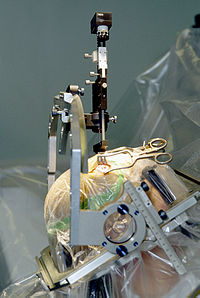
Photo from wikipedia
BACKGROUND: Normal pressure hydrocephalus (NPH) is characterized by cerebral ventriculomegaly and the triad of magnetic gait, urinary incontinence, and cognitive impairment. Treatment includes ventriculoperitoneal (VP) shunt surgery. OBJECTIVE: To evaluate… Click to show full abstract
BACKGROUND: Normal pressure hydrocephalus (NPH) is characterized by cerebral ventriculomegaly and the triad of magnetic gait, urinary incontinence, and cognitive impairment. Treatment includes ventriculoperitoneal (VP) shunt surgery. OBJECTIVE: To evaluate complication rates in a cohort of patients undergoing VP shunt surgery with stereotactic proximal catheter navigation and laparoscopic distal catheter placement. METHODS: This study was a retrospective consecutive cohort analysis of 117 patients with NPH undergoing VP shunt placement using both stereotactic navigation and laparoscopy from 2015 to 2020. Patients with obstructive hydrocephalus and those with central nervous system infection, intraventricular hemorrhage, Ommaya reservoirs, or undergoing shunt revision at initial encounter were excluded. Variables included demographics and comorbidities, NPH symptoms, operative details, radiographic outcomes, and rates of complications, readmissions, and reoperations within 1, 3, and 12 months. Impact of demographics and comorbidities on complication rates was assessed using Fisher exact tests. RESULTS: Zero patients required reoperation within 30 days. One intracranial hemorrhage was detected on immediate postoperative head computed tomography. Four patients ultimately required revision: 2 for catheter repositioning to alleviate abdominal pain, 1 ligation for a colectomy, and 1 removal for shunt infection. Patients with cardiac or other neurological comorbidities had higher rates of readmission and complications. Systemic complications totaled 12% in the first 30 days. CONCLUSION: The combination of intraoperative stereotactic navigation and laparoscopic assistance leads to low rates of serious complications and reoperations for VP shunt implantation in patients with NPH. These changes to surgical technique are easy to implement and may reduce the risk for this common operation.
Journal Title: Operative Neurosurgery
Year Published: 2022
Link to full text (if available)
Share on Social Media: Sign Up to like & get
recommendations!